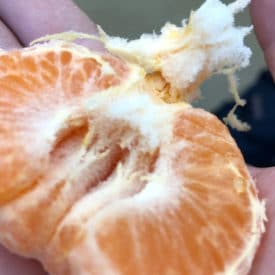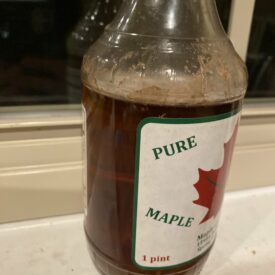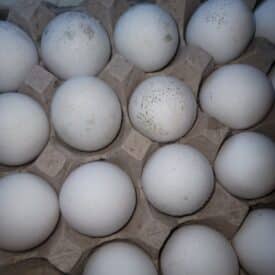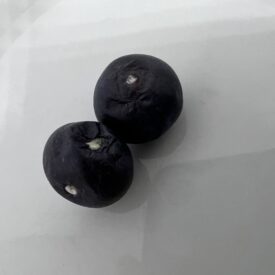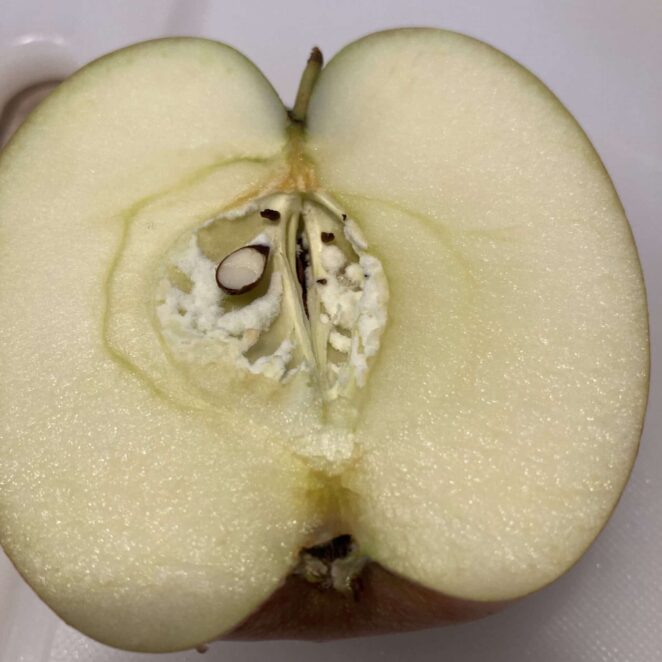
What you see: Tight bundles of white fuzz around the seed cavities in your apple core; you may be worried your apple is moldy.
What it is: If the apple otherwise looks healthy, the fuzzy bits are probably harmless callus tissue–just bonus growth from the apple. Callus tissue is relatively hard and dense; mold will be wispy and soft.
Eat or toss: The apple is fine to eat!
What are those white clumps in some apple cores? Are they mold?
A white growth often shows up in the seed cavities of apples. You might worry it’s mold. But it’s actually some bonus cellular growth called “callus tissue.” Callus tissue is simply generic plant tissue that isn’t programmed for a specific function. Anna Wallis, fruit coordinator for New York State’s Integrated Pest Management Program, compared it to stem cells. And an apple whose only abnormality is some extra callus tissue in its core is completely OK to eat.
Just like the rest of the core, the white tufts aren’t worth eating, but if you were to sample those white clumps, Wallis predicted: “It would probably be more dense than the flesh of the apple and wouldn’t have much taste.”
How can you tell if your apple core is moldy?
A variety of molds with different characteristics can form within an apple’s seed cavities; mold might, for example, might make the seed nooks look as if they’re filled with cobwebs. While a mold’s thread-like structures can be white, it will probably look darker and less “bright” than callus tissue. And while you can find instances where mold only inhabits the seed cavities, mold often advances past the core, into the apple’s flesh where it will turn things brown and soft. At this point the apple has gone from “moldy core” to “core rot.” You’ll want to toss (hopefully compost) it.
How is callus tissue different from mold in the core?
Callus tissue, on the other hand, is typically bright white and forms tight little tufts. In a core with bonus callus tissue, the rest of the apple tissue will probably look pristine. To understand the difference between callus tissue and mold, look at the apple overall. If it looks healthy, the “growth” in the seed cavities looks dense and feels hard and there’s no evidence that the flesh is rotting (turning brown, soft, etc.), it’s unlikely that a fungus is at work.
While we don’t all have microscopes in our kitchens, if you were to closely examine callus tissue and mold, you’d see that callus tissue cells are much wider than mold cells.

Why do those white tufts form in apple cores?
Wallis, whose organization is part of Cornell University’s Agritech program, said it’s possible that the callus tissue has protective properties. And some apple varieties seem genetically predisposed.
Which apple varieties are more likely to develop white tissue in the core?
Wallis said she often sees callus tissue in Red Delicious, Honeycrisp and Gala apples. But other varieties can also develop it.
Emma, the EatOrToss reader who submitted the image at the top of the post, reported that hers was a Fuji apple. And, thanks Emma for sharing your apple with us! (Submit your own EatOrToss questions here.)
How do apple cores get moldy, even if the outside looks fine?
Molds can sneak into what will become the apple core when it’s still a blossom on the tree. It can also find its way up the narrow channel, called the “sinus” that goes from the indentation at the bottom of the apple, called the calyx (this is all that remains of the apple flower) up into the core (check out a cool progression of an apple from flower to fruit here). Some mold spores hitchhike through the sinus on tiny mites. Weather patterns can increase the odds of moldy core, especially if a dry early summer is followed by a wet late summer. Or if things are extra damp when the trees are blooming. Mold loves moisture.
“The major predisposing factor in fruit that frequently get moldy core is the ‘open sinus’ from the calyx to the core/seed cavities,” Wallis said. “This allows moisture to enter and create a humid environment for the mold to grow.”
According to Fusion 360, a company that sells soil treatments to farmers, some types of apples, like Red Delicious and Fuji, have larger sinuses, making it easier for fungi to invade their cores. Granny Smith apples cores are less vulnerable to mold as they have smaller sinuses. (So, it turns out that humans are not the only ones who can get sinus infections!)
SOURCES:
- Anna Wallis, Fruit IPM Coordinator. New York State Integrated Pest Management. Cornell AgriTech. Cornell University.
- Callus tissue versus moldy core in apples. Anna Wallis, Michigan State University Extension; Dan Donahue and Dave Rosenberger, Cornell University. Michigan State University Extension. October 04, 2022
- Moldy Core of Apple. Thomas T. Yamashita. Fusion 360 LLC. APRIL 15, 2019.
- Trichothecium roseum Enters ‘Fuji’ Apple Cores Through Stylar Fissures
- Pengbo Dai, Yuanyuan Jiang, Xiaofei Liang, Mark L. Gleason, Rong Zhang, and Guangyu Sun. Plant Disease 2020 104:4, 1060-1068
- Moldy Core Of Apple. Pennsylvania State University. Updated Jan. 20, 2017. (Article no longer available online.)
I don’t mean to be callus, but the tissue on your apple is a little rough.

